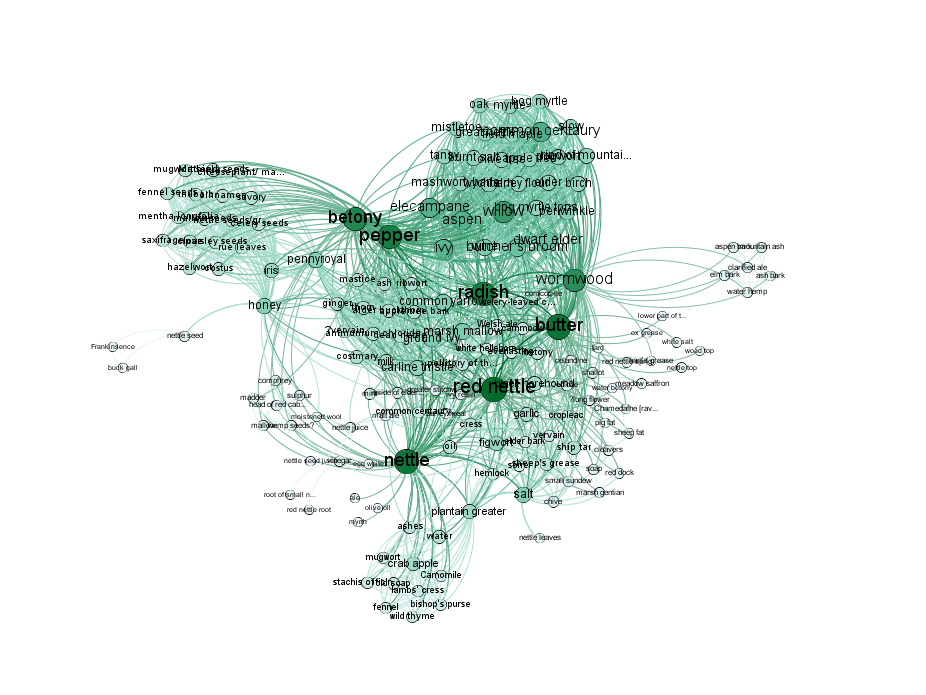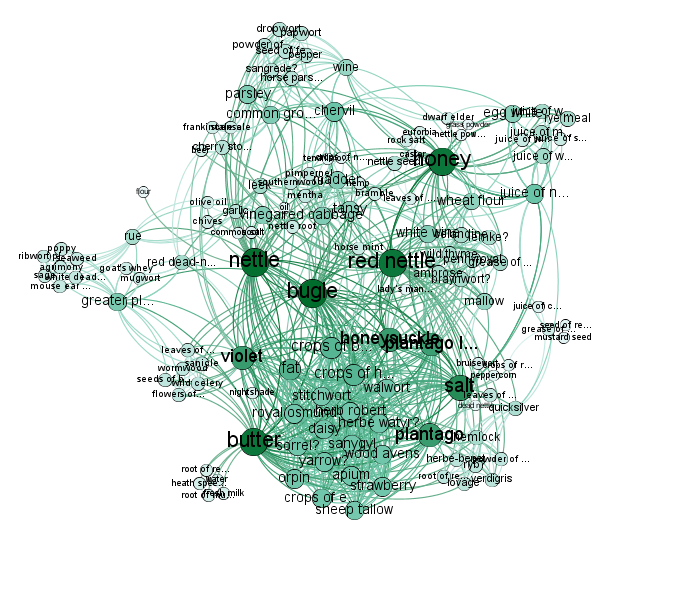Outcomes & Engagements
Venous system, LJS 49, f. 19v
Publications
Click on articles in blue (where available) to be taken directly to the publication (open access):
- Sweet and sour synergy: exploring the antibacterial and antibiofilm activity of acetic acid and vinegar combined with medical-grade honeys, 2023
- Health and Healing in Early Medieval England (forthcoming)
- An assessment of the evidence for antibacterial activity of stinging nettle (Urtica dioica) extracts, 2022
- The Art of Looking Good: Hair and Beauty Remedies in Early Medieval Texts and Contexts, in: Art and Worship in the Insular World, ed. G. Owen-Crocker and M. Clegg-Hyer, pp 45-67. Brill: 2021
- IMC (International Medieval Congress) Leeds 2023
- IMC (International Medieval Congress) Kalamazoo 2023
- MRC Doctoral Training Partnership Symposium, 2023. View the Powerpoint here.
- The Chemistry and Biology of Natural Products Symposium XVI, Warwick, June 2023
- Microbiology Society Annual Conference Birmingham, April 2023
- International Medieval Congress Leeds, ‘Nettles and Networks,’ July 2022
- Society for Microbiology Focussed Meeting, ‘Antimicrobial drug discovery from traditional and historical medicine,’ October 2019; Interview with Freya Harrison
- 2019 ISSIME/ Meeting of the Society for Anglo-Saxonists, ‘Ancientbiotics: What’s Next’ (with focus on Nettles research), August 2019
Radio:
- BBC Radio 4 Sideways: An Appointment with Dr Leech
- Naomi Alderman: Science Stories
- Radiolab Staph Retreat
TV:
- Channel 5: The Vikings (Episode 2)
- BBC Countryfile (9th April 2023)
- Terra X ZDFmediathek Ein Tag im Mittelater (in German)
- National Geographic 1,000 Year Old Remedy May Cure MRSA, Still Faces Market Hurdles
Michael Firth, 2023
Michael worked as a Research Assistant Intern to Dr. Christina Lee from the 26th June – 21st July 2023, his work was mainly surrounding building tools, content and resdesigning the Ancientbiotics website, as well as assisting Dr. Lee in relation to the public engagement of the Plants & Prayers exhibit, read his blog for this experience below:
“I became Dr Lee’s intern through the Summer Research Placement Programme offered at the University of Nottingham. As someone who studies Ancient Greco-Roman and Ancient Mediterranean history, entering the field of medieval medicine was intimidating to begin, but I quickly found it exciting to learn history that is new to me whilst also performing paid work. In addition, this aided Dr Lee in approaching some of the public-facing content, as I could give honest feedback as to what is suitable to an audience with less expertise in this historical period and field of study. I feel that ‘Research Assistant’ does not begin to cover the rewarding work I have done during this placement, due to the exciting opportunities that I have been able to take advantage of and the amount of vastly different work I’ve approached. Overall, working with this amazing and talented interdisciplinary team has been a truly rewarding experience. Not only have I developed research, liaison, and other essential skills for this career prospect, I have also met and worked with some fantastic people along the way, who all offered support and guidance at every hurdle. I started the internship knowing I would learn a significant amount about the field of research; I have finished the internship not only with this knowledge and experience but also with the proud feeling that I have in some way assisted a team that I believe is making genuine milestones which will greatly benefit the disciplines of English, history and biology and our health for many years to come.”
Mutiat Akamo, 2023
Mutiat is an History of Art and English student who worked as an Research Assistant Intern through the ‘Excellence in Science’ programme at the University of Nottingham, supervised Dr. Christina Lee and working closely with Dr. Erin Connelly. She worked closely with the Plants & Prayers 2023 exhibit, conducting relevant research and working on the outreach – particularly for diverse demographics. She also wrote a fantastic pamphlet regarding the colonial attitudes towards traditional African medicine. Click here to view her full blog about her experience.
Summer Studentships
Two graduates, Jason Millington from the University of Nottingham and Thorulf Vargsen from the University of Oxford, spent their summer working with Dr Freya Harrison at the University of Nottingham to assist with the ‘Bald’s Eyesalve’ project. This was under a summer studentship. Jason explored the activity of Bald’s eyesalve against various clinical isolates of S. aureus, and he also investigated whether storage conditions affected the eyesalve’s activity. Thorulf tested the eyesalve’s activity against clinical isolates of different species of bacteria, and he also started to look at the effects of the eyesalve on human cells. Both students produced a lay report of their work to share with the contributors to the crowdfunding campaign which supported their summer studentships.
Youtube
BSHP British Society for the History of Pharmacy Unlocking the Medieval Medicine Cabinet
Network Visualisations of Nettle Remedies
Network Analysis is a useful tool to examine how elements interact with one another through a series of connections using visualisations. These elements can theoretically be anything from people, places, objects, etc. Here we use a network-theoretical approach alongside conventional literary and historical methods to analyse the co-occurrence of ingredients in medieval remedies. This interdisciplinary methodology allows us to gain insight into which ingredients were often used together, identify the most prominent ingredients in the network, and to see if new questions arise from these visualisations. To visualise networks of ingredients, we manually extracted medieval remedies from selected medical texts (see Publications).
For this project, ingredients are conceptualised as ‘nodes’, the elements being connected on visualisations. On the network graphs, nodes appear as circles. Ingredients are linked to one another if they are included in the same remedy. For instance, if a remedy included nettles, oil, and salt all of these ingredients would be individually linked to each other (nettles-oil, nettles-salt, and oil-salt). Therefore three relationships are visualised from this remedy on the graph as ‘edges’ the visual representation of connections between nodes that appear as lines on a visualisation. Nodes and edges combined form a network which can then be analysed. It is important to note that visualisations are a tool to be used in aiding research and are not the final product of the research. Below are visualisations constructed by connecting ingredients in Old English/Latin and Middle English remedies. These datasets and visualisations are analysed separately at present. This work was supported by a Royal Society APEX Award, and based on a technique developed by Connelly (supported by UKRI FLF), Harrison, and del Genio.
Network of Old English Remedies

This network visualisation is derived from a sample of 73 remedies found in Old English and some Latin sources. Remedies were only included in the network visualisation if they were comprised of more than one ingredient because we are looking at ingredient combination and co-occurrences. In this sample, 165 unique ingredients were identified and serve as the ‘nodes’ in the visualisation because they are the entities being connected. In this network there are 1,824 edges, connections between ingredients. Most of the network can be seen in this visualisation, there are two remedies that are not connected to main section of the network due to the confines of space, but this suggests that most ingredients were interconnected on whole.
The size and colour of a node displays how often an ingredient was used within remedies. The larger and darker the node is, the more connections with other ingredients that it has. Here nettles, red nettles, butter, radish, betony, and pepper appear to be the most frequent ingredients. These findings are interesting because pepper is not native to the United Kingdom and must have been imported. The smaller, lighter nodes that often appear on the fringes of the network are found in fewer remedies and often only have one or two occurrences in remedies.
Network of Middle English Remedies
This network visualisation is derived from a sample of 66 remedies found in Middle English sources. Remedies were only included in the network visualisation if they were comprised of more than one ingredient because we are looking at ingredient combination and co-occurrences.
In this sample, 135 unique ingredients were identified and serve as the ‘nodes’ in the visualisation because they are the entities being connected. In this network there are 991 edges, connections between ingredients. Most of the network can be seen in this visualisation, there is only 1 remedy that is not connected to the main section of the network due to the confines of space, but this suggests that most ingredients were interconnected overall.
The size and colour of a node displays how often an ingredient was used within remedies. The larger and darker the node is, the more connections with other ingredients that it has.





